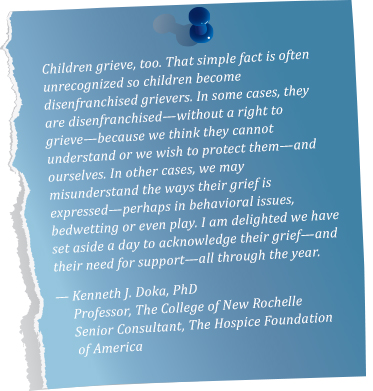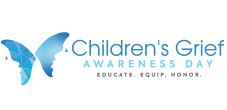Vision, Mission & Goals
Vision
A world of support for grieving children.
Mission
To help grieving children feel less alone and more supported through changing the culture surrounding children and grief.
Goals
- Raise awareness of the impact of death on children
- Raise awareness of the benefits of support for grieving children
- Provide information in order to increase the general knowledge of the needs of grieving children
- Make resources available to raise this awareness and increase this knowledge
What is Children's Grief Awareness Day?
Created in 2008 by the Highmark Caring Place, A Center for Grieving Children, Adolescents and Their Families, and since recognized by organizations around the world, Children's Grief Awareness Day is observed every year on the third Thursday in November (the Thursday before the U.S. holiday of Thanksgiving). This time of year is a particularly appropriate time to support grieving children because the holiday season is often an especially difficult time after a death.
Children's Grief Awareness Day seeks to bring attention to the fact that often support can make all the difference in the life of a grieving child. It provides an opportunity for all of us to raise awareness of the painful impact that the death of a loved one has in the life of a child, an opportunity to make sure that these children receive the support they need.
Check out ways to participate in Children's Grief Awareness Day.
Children and grief
Before they graduate from high school, one child out of every 20 children will have a parent die—and that number doesn't include those who experience the death of a brother or sister, a close grandparent, an aunt or uncle, or friend.
Children who have experienced the death of someone important to them often feel like their struggles are invisible to those around them. These children need advocates, letting all know that the death of someone close is the beginning of many weeks, months and years of finding ways to go on without that special person in their lives, with that person-shaped hole in their hearts.
 Children who have had someone die—especially a close family member—can feel the loss forever. They eventually go back to school. They might pick some activities back up. They certainly look "normal." And yet there's still that hole inside.
Children who have had someone die—especially a close family member—can feel the loss forever. They eventually go back to school. They might pick some activities back up. They certainly look "normal." And yet there's still that hole inside.
Grieving children often feel set apart, different from their peers, alone and not understood. Every school and every community has children who have experienced some type of loss. Even if they keep their loss and experience to themselves, there are many children who are grieving among us.
These children can be helped to not feel so alone. Children and adults together can show their support for grieving children and show their awareness of what grieving children might be going through by participating in Children's Grief Awareness Day.
A special day to remember—how it began
Children's Grief Awareness Day began in Pennsylvania from a desire on the part of students to do more to bring attention to what their grieving classmates were coping with, for the most part, in silence. This initiative grew out of an ongoing partnership of the Highmark Caring Place with hundreds of schools across the state.
After learning more about the work of the Caring Place and learning about how alone and misunderstood their peers often feel after a death, Caring Place staff and these students worked together to inaugurate the first Children's Grief Awareness Day in 2008.
 Since that time, thousands of individuals and organizations, along with local, state and national leaders from across the U.S., have worked to raise awareness of grieving children and to change the culture in order to make death and grief a topic that can be spoken of openly and compassionately.
Since that time, thousands of individuals and organizations, along with local, state and national leaders from across the U.S., have worked to raise awareness of grieving children and to change the culture in order to make death and grief a topic that can be spoken of openly and compassionately.
Why raise awareness for grieving kids and teens?
Many people don’t realize that it takes most children much longer to deal with their grief than we expect and that the amount of inner turmoil, invisible to most, is much more intense than we have any idea of. We raise awareness so that people will realize that even if there is no outward sign of inner turmoil, those storms can still be raging inside a grieving child’s heart.
We raise awareness so that people will understand that a grieving child can't just "get over it"—not in any set time period, not by any act of their own will—and that there's no reason that they should just "get over it."
We raise awareness in order to help people learn ways they might help a grieving child they happen to know, now or in the future.





